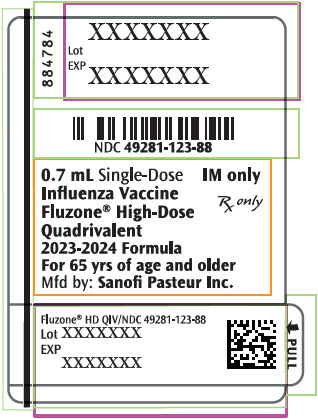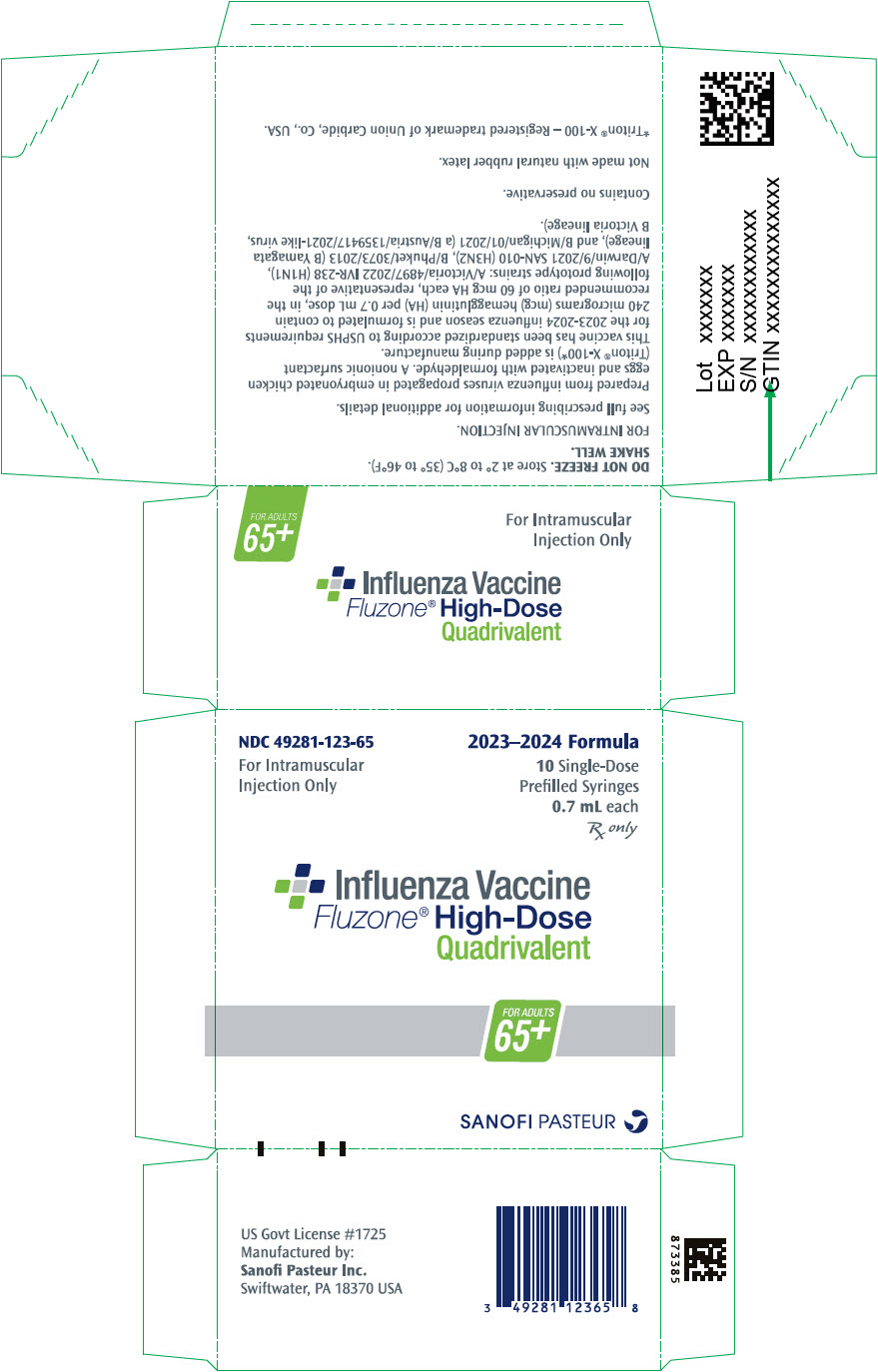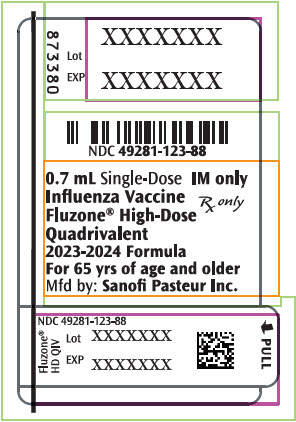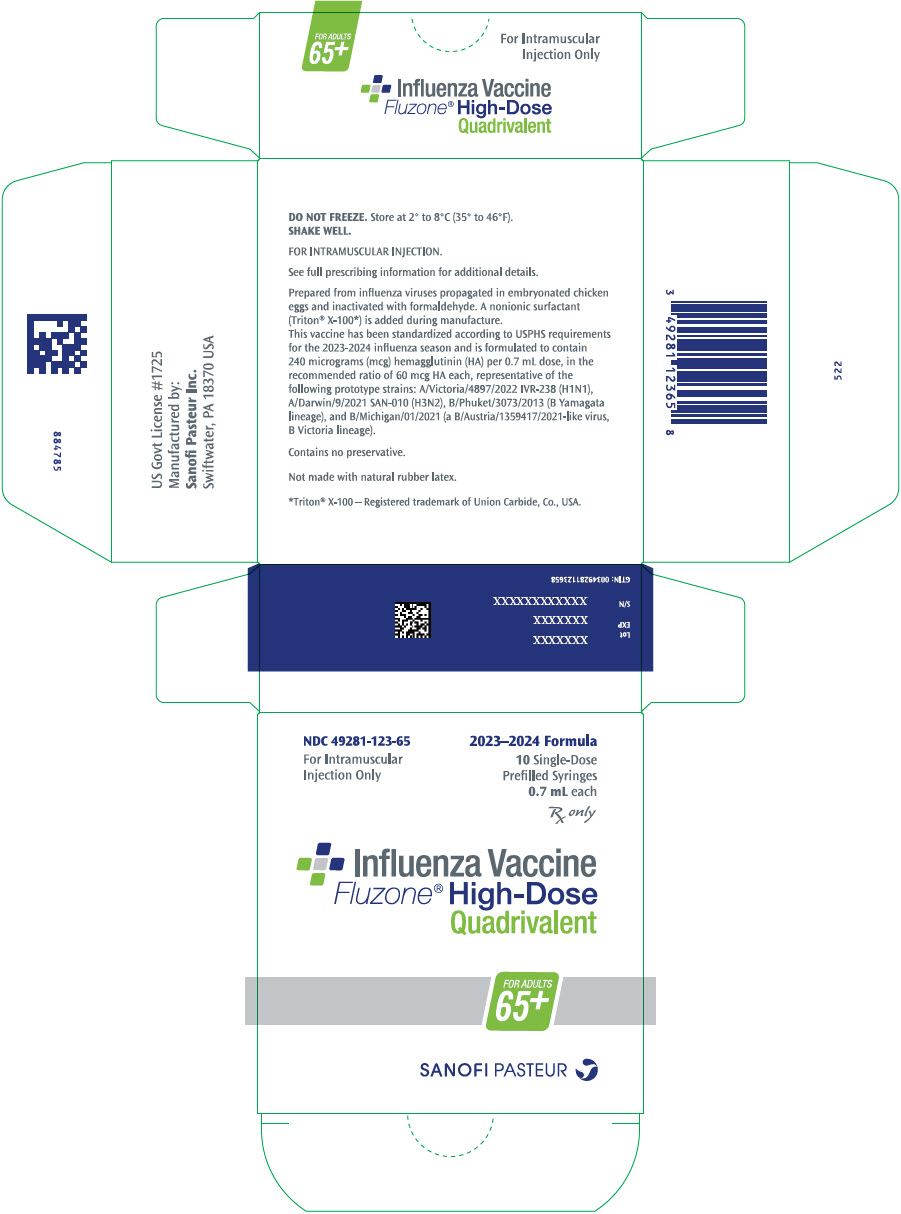FULL PRESCRIBING INFORMATION
1 INDICATIONS AND USAGE
Fluzone® High-Dose Quadrivalent is a vaccine indicated for active immunization for the prevention of influenza caused by influenza A subtype viruses and type B viruses contained in the vaccine.
Fluzone High-Dose Quadrivalent is indicated for use in persons 65 years of age and older.
2 DOSAGE AND ADMINISTRATION
For intramuscular use only
2.1 Dose and Schedule
Fluzone High-Dose Quadrivalent should be administered as a single 0.7 mL injection by the intramuscular route in adults 65 years of age and older.
2.2 Administration
Inspect Fluzone High-Dose Quadrivalent visually for particulate matter and/or discoloration prior to administration. If either of these conditions exists the vaccine should not be administered.
Before administering a dose of vaccine, shake the prefilled syringe.
The preferred site for intramuscular injection is the deltoid muscle. The vaccine should not be injected into the gluteal area or areas where there may be a major nerve trunk.
Do not administer this product intravenously.
Fluzone High-Dose Quadrivalent should not be combined through reconstitution or mixed with any other vaccine.
3 DOSAGE FORMS AND STRENGTHS
Fluzone High-Dose Quadrivalent is a suspension for injection.
Fluzone High-Dose Quadrivalent is supplied in prefilled syringes, 0.7 mL, for adults 65 years of age and older.
4 CONTRAINDICATIONS
A severe allergic reaction (e.g., anaphylaxis) to any component of the vaccine [see Description (11)], including egg protein, or to a previous dose of any influenza vaccine is a contraindication to administration of Fluzone High-Dose Quadrivalent.
5 WARNINGS AND PRECAUTIONS
5.1 Guillain-Barré Syndrome
If Guillain-Barré syndrome (GBS) has occurred within 6 weeks following any previous influenza vaccination, the decision to give Fluzone High-Dose Quadrivalent should be based on careful consideration of the potential benefits and risks.
The 1976 swine influenza vaccine was associated with an elevated risk of GBS. Evidence for a causal relation of GBS with other influenza vaccines is inconclusive; if an excess risk exists, it is probably slightly more than 1 additional case per 1 million persons vaccinated. GBS has also been temporally associated with influenza disease. (See references 1 and 2.)
5.2 Preventing and Managing Allergic Reactions
Appropriate medical treatment and supervision must be available to manage possible anaphylactic reactions following administration of the vaccine.
5.3 Altered Immunocompetence
If Fluzone High-Dose Quadrivalent is administered to immunocompromised persons, including those receiving immunosuppressive therapy, the immune response may be lower than expected.
6 ADVERSE REACTIONS
6.1 Clinical Trials Experience
Because clinical trials are conducted under widely varying conditions, adverse event rates observed in the clinical trial(s) of a vaccine cannot be directly compared to rates in the clinical trial(s) of another vaccine and may not reflect the rates observed in practice. One clinical study has evaluated the safety of Fluzone High-Dose Quadrivalent.
Study 1 (NCT03282240, see https://clinicaltrials.gov) was a randomized, active-controlled, modified double-blind pre-licensure trial conducted in the U.S. The study compared the safety and immunogenicity of Fluzone High-Dose Quadrivalent to those of Fluzone High-Dose (trivalent formulation). The safety analysis set included 1777 Fluzone High-Dose Quadrivalent recipients, 443 Fluzone High-Dose recipients, and 450 investigational Fluzone High-Dose containing the alternate B influenza strain recipients.
The most common reactions occurring after Fluzone High-Dose Quadrivalent administration were injection-site pain (41.3%), myalgia (22.7%), headache (14.4%), and malaise (13.2%). Onset usually occurred within the first 3 days after vaccination. The majority of solicited reactions resolved within three days of vaccination.
Table 1 displays solicited adverse reactions for Fluzone High-Dose Quadrivalent compared to Fluzone High-Dose reported within 7 days after vaccination and collected using standardized diary cards.
| Fluzone High-Dose Quadrivalent (N†=1761-1768) | Fluzone High-Dose‡ (N†=885-889) | |||
|---|---|---|---|---|
| Percentage | Percentage | |||
| Any | Grade 3 | Any | Grade 3 | |
|
||||
| Local Reactions | ||||
| Injection Site Pain§ | 41.3 | 0.7 | 36.4 | 0.2 |
| Injection Site Erythema¶ | 6.2 | 0.6 | 5.7 | 0.2 |
| Injection Site Swelling¶ | 4.9 | 0.3 | 4.7 | 0.1 |
| Injection Site Induration¶ | 3.7 | 0.2 | 3.5 | 0.1 |
| Injection Site Bruising¶ | 1.3 | 0.0 | 1.1 | 0.0 |
| Systemic Reactions | ||||
| Myalgia§ | 22.7 | 0.9 | 18.9 | 0.7 |
| Headache§ | 14.4 | 0.6 | 13.6 | 0.4 |
| Malaise§ | 13.2 | 0.7 | 13.4 | 0.4 |
| Shivering§ | 5.4 | 0.3 | 4.7 | 0.3 |
| Fever# | 0.4 | 0.2 | 0.9 | 0.2 |
Based on data from Fluzone High-Dose, solicited injection site reactions and systemic adverse reactions were slightly more frequent after vaccination with Fluzone High-Dose compared to a standard-dose vaccine.
Unsolicited non-serious adverse events were reported in 279 (15.7%) recipients in the Fluzone High-Dose Quadrivalent group and 140 (15.7%) recipients in the Fluzone High-Dose group. The most commonly reported unsolicited adverse event was cough.
Within 180 days post-vaccination, 80 (4.5%) Fluzone High-Dose Quadrivalent recipients and 48 (5.4%) Fluzone High-Dose recipients experienced a serious adverse event (SAE). None of the SAEs were assessed as related to the study vaccines.
6.2 Postmarketing Experience
The following additional adverse events have been spontaneously reported during the postmarketing use of Fluzone High-Dose, Fluzone, or Fluzone Quadrivalent and may occur in people receiving Fluzone High-Dose Quadrivalent. Because these events are reported voluntarily from a population of uncertain size, it is not always possible to reliably estimate their frequency or establish a causal relationship to vaccine exposure. Adverse events were included based on one or more of the following factors: severity, frequency of reporting, or strength of evidence for a causal relationship to Fluzone High-Dose, Fluzone, or Fluzone Quadrivalent.
- Blood and Lymphatic System Disorders: Thrombocytopenia, lymphadenopathy
- Immune System Disorders: Anaphylaxis, other allergic/hypersensitivity reactions (including urticaria, angioedema)
- Eye Disorders: Ocular hyperemia
- Nervous System Disorders: Guillain-Barré syndrome (GBS), convulsions, febrile convulsions, myelitis (including encephalomyelitis and transverse myelitis), facial palsy (Bell's palsy), optic neuritis/neuropathy, brachial neuritis, syncope (shortly after vaccination), dizziness, paresthesia
- Vascular Disorders: Vasculitis, vasodilatation
- Respiratory, Thoracic and Mediastinal Disorders: Dyspnea, cough, wheezing, throat tightness, oropharyngeal pain, and rhinorrhea
- Gastrointestinal Disorders: Vomiting
- Skin and Subcutaneous Tissue Disorders: Stevens-Johnson syndrome
- General Disorders and Administration Site Conditions: pruritus, asthenia/fatigue, chest pain, chills
8 USE IN SPECIFIC POPULATIONS
8.1 Pregnancy
Fluzone High-Dose Quadrivalent is not approved for use in persons <65 years of age. There are limited human data on Fluzone High-Dose and no animal data available on Fluzone High-Dose Quadrivalent to establish whether there is a vaccine-associated risk with use of Fluzone High-Dose Quadrivalent in pregnancy.
8.2 Lactation
Fluzone High-Dose Quadrivalent is not approved for use in persons <65 years of age. No human or animal data are available to assess the effects of Fluzone High-Dose Quadrivalent on the breastfed infant or on milk production/excretion.
8.4 Pediatric Use
Safety and effectiveness of Fluzone High-Dose Quadrivalent in children younger than 18 years of age have not been established.
8.5 Geriatric Use
Safety, immunogenicity, and efficacy of Fluzone High-Dose Quadrivalent have been evaluated in adults 65 years of age and older [see Adverse Reactions (6.1) and Clinical Studies (14)].
11 DESCRIPTION
Fluzone High-Dose Quadrivalent for intramuscular injection is an inactivated influenza vaccine, prepared from influenza viruses propagated in embryonated chicken eggs. The virus-containing allantoic fluid is harvested and inactivated with formaldehyde. Influenza virus is concentrated and purified in a linear sucrose density gradient solution using a continuous flow centrifuge. The virus is then chemically disrupted using a non-ionic surfactant, octylphenol ethoxylate (Triton® X-100), producing a "split virus." The split virus is further purified and then suspended in sodium phosphate-buffered isotonic sodium chloride solution. The Fluzone High-Dose Quadrivalent process uses an additional concentration factor after the ultrafiltration step in order to obtain a higher hemagglutinin (HA) antigen concentration.
Fluzone High-Dose Quadrivalent suspension for injection is a colorless opalescent liquid.
Neither antibiotics nor preservative are used in the manufacture of Fluzone High-Dose Quadrivalent.
The Fluzone High-Dose Quadrivalent prefilled syringe presentation is not made with natural rubber latex.
Fluzone High-Dose Quadrivalent is standardized according to United States Public Health Service requirements and is formulated to contain HA of each of the following four influenza strains recommended for the 2023-2024 influenza season: A/Victoria/4897/2022 IVR-238 (H1N1), A/Darwin/9/2021 SAN-010 (H3N2), B/Phuket/3073/2013 (B Yamagata lineage), and B/Michigan/01/2021 (a B/Austria/1359417/2021-like virus, B Victoria lineage).
The amounts of HA and other ingredients per dose of vaccine are listed in Table 2.
| Ingredient | Quantity (per dose) |
|---|---|
| Fluzone High-Dose Quadrivalent 0.7 mL Dose |
|
| Active Substance: Split influenza virus, inactivated strains*: | 240 mcg HA total |
| A (H1N1) | 60 mcg HA |
| A (H3N2) | 60 mcg HA |
| B (Victoria Lineage) | 60 mcg HA |
| B (Yamagata Lineage) | 60 mcg HA |
| Other: | |
| Sodium phosphate-buffered isotonic sodium chloride solution | QS† to appropriate volume |
| Formaldehyde | ≤140 mcg |
| Octylphenol ethoxylate | ≤350 mcg |
| Gelatin | None |
| Preservative | None |
12 CLINICAL PHARMACOLOGY
12.1 Mechanism of Action
Influenza illness and its complications may follow influenza infection. Global surveillance of influenza viruses identifies yearly antigenic variants. Since 1977, antigenic variants of influenza A (H1N1 and H3N2) viruses and influenza B viruses have been in global circulation. Specific levels of hemagglutination inhibition (HI) antibody titer post-vaccination with inactivated influenza virus vaccines have not been correlated with protection from influenza virus infection. In some human studies, antibody titers ≥1:40 have been associated with protection from influenza illness in up to 50% of participants. (See references 3 and 4.)
Antibodies against one influenza virus type or subtype confer limited or no protection against another. Furthermore, antibodies to one antigenic variant of influenza virus might not protect against a new antigenic variant of the same type or subtype. Frequent development of antigenic variants through antigenic drift is the virologic basis for seasonal epidemics and the reason for the usual change of one or more new strains in each year's influenza vaccine. Therefore, influenza vaccines are standardized to contain the hemagglutinins of influenza virus strains representing the influenza viruses likely to be circulating in the U.S. during the influenza season.
Fluzone High-Dose Quadrivalent stimulates the immune system to produce antibodies that help prevent influenza disease.
14 CLINICAL STUDIES
14.1 Immunogenicity of Fluzone High-Dose Quadrivalent in Adults 65 Years of Age and Older
Study 1 (NCT03282240, see http://clinicaltrials.gov) was a randomized, active-controlled, modified double-blind trial in adults 65 years of age and older conducted in the US. The study compared the safety and immunogenicity of Fluzone High-Dose Quadrivalent to those of Fluzone High-Dose. The objective was to demonstrate immunologic non-inferiority of Fluzone High-Dose Quadrivalent to Fluzone High-Dose, as assessed by HAI geometric mean antibody titers (GMTs) at Day 28 and seroconversion rates, to strains common to formulations of both vaccines, based on pre-specified criteria.
A total of 2670 adults from 65 years of age were randomized (4:1:1) to receive one dose of either Fluzone High-Dose Quadrivalent or one of two formulations of Fluzone High-Dose (one formulation contained a B strain of the Victoria lineage [TIV-HD1] while the other contained a B strain of the Yamagata lineage [TIV-HD2]).
Females accounted for 58.2% of participants in the Fluzone High-Dose Quadrivalent group and 57.4% of participants in the Fluzone High-Dose group (TIV-HD1 and TIV-HD2, pooled). The mean age was 72.9 years (range: 65 through 100 years) in the Fluzone High-Dose Quadrivalent group and the mean age was 73.0 (range: 65 through 95 years) in the Fluzone High-Dose group. The percentage of subjects 75 years of age or older was 35.4% in the Fluzone High-Dose Quadrivalent group and 35.8% in the Fluzone High-Dose group. Most participants were White (91.2% and 89.7%), followed by Black (6.8% and 8.0%), and Hispanic (2.8% and 2.6%) in the Fluzone High-Dose Quadrivalent and Fluzone High-Dose groups, respectively.
The immunogenicity results of Study 1 are summarized in Table 3 and Table 4 below.
| Influenza Strain | GMT | GMT Ratio | Met Predefined Non-inferiority Criteria† | ||
|---|---|---|---|---|---|
| QIV-HD | TIV-HD1‡
(B1 Victoria) | TIV-HD2§
(B2 Yamagata) | QIV-HD over TIV-HD (95% CI) |
||
| N¶=1679-1680 | N¶=423 | N¶=430 | |||
|
|||||
| A (H1N1)# | 312 | 374 | 0.83 (0.744; 0.932) | Yes | |
| A (H3N2)# | 563 | 594 | 0.95 (0.842; 1.066) | Yes | |
| B1 (Victoria) | 516 | 476 | -- | 1.08 (0.958; 1.224) | Yes |
| B2 (Yamagata) | 578 | -- | 580 | 1.00 (0.881; 1.129) | Yes |
| Influenza Strain | Seroconversion Rates (Percentage)† | Difference of Seroconversion Rates | Met Predefined Non-inferiority Criteria‡ | ||
|---|---|---|---|---|---|
| QIV-HD | TIV-HD1§
(B1 Victoria) | TIV-HD2¶
(B2 Yamagata) | QIV-HD minus TIV-HD (95% CI) |
||
| N#=1668-1669 | N#=420-421 | N#=428 | |||
|
|||||
| A (H1N1)Þ | 50.4 | 53.7 | -3.27 (-7.37; 0.86) | Yes | |
| A (H3N2)Þ | 49.8 | 50.5 | -0.71 (-4.83; 3.42) | Yes | |
| B1 (Victoria) | 36.5 | 39.0 | -- | -2.41 (-7.66; 2.70) | Yes |
| B2 (Yamagata) | 46.6 | -- | 48.4 | -1.75 (-7.04; 3.53) | Yes |
Fluzone High-Dose Quadrivalent was as immunogenic as Fluzone High-Dose for GMTs and seroconversion rates for the common influenza strains. Fluzone High-Dose Quadrivalent induced a superior immune response, based on a pre-specified superiority criterion, with respect to the additional B strain than the immune response induced by Fluzone High-Dose formulation that did not contain the additional B strain.
14.2 Efficacy of Fluzone High-Dose in Adults 65 Years of Age and Older
The efficacy of Fluzone High-Dose (trivalent formulation) is relevant to Fluzone High-Dose Quadrivalent since both vaccines are manufactured according to the same process and have overlapping compositions.
Study 2 (NCT01427309) was a multi-center, double-blind, post-licensure efficacy trial conducted in the U.S. and Canada in which adults 65 years of age and older were randomized (1:1) to receive either Fluzone High-Dose or Fluzone. The study was conducted over two influenza seasons (2011-2012 and 2012-2013); 53% of participants enrolled in the first year of the study were re-enrolled and re-randomized in the second year. The per-protocol analysis set for efficacy assessments included 15,892 Fluzone High-Dose recipients and 15,911 Fluzone recipients. The majority (67%) of participants in the per-protocol analysis set for efficacy had one or more high-risk chronic comorbid conditions.
In the per-protocol analysis set, females accounted for 57.2% of participants in the Fluzone High-Dose group and 56.1% of participants in the Fluzone group. In both groups, the median age was 72.2 years (range 65 through 100 years). Overall, most participants in the study were White (95%); approximately 4% of study participants were Black, and approximately 6% reported Hispanic ethnicity.
The primary endpoint of the study was the occurrence of laboratory-confirmed influenza (as determined by culture or polymerase chain reaction) caused by any influenza viral type/subtype in association with influenza-like illness (ILI), defined as the occurrence of at least one of the following respiratory symptoms: sore throat, cough, sputum production, wheezing, or difficulty breathing; concurrent with at least one of the following systemic signs or symptoms: temperature >99.0°F, chills, tiredness, headaches or myalgia. Participants were monitored for the occurrence of a respiratory illness by both active and passive surveillance, starting 2 weeks post-vaccination for approximately 7 months. After an episode of respiratory illness, nasopharyngeal swab samples were collected for analysis; attack rates and vaccine efficacy were calculated (see Table 5).
| Fluzone High-Dose N§=15,892 n¶ (%) | Fluzone N§=15,911 n¶ (%) | Relative Efficacy % (95% CI) |
|
|---|---|---|---|
|
|||
| Any type/subtype# | 227 (1.43) | 300 (1.89) | 24.2 (9.7; 36.5)Þ |
| Influenza A | 190 (1.20) | 249 (1.56) | 23.6 (7.4; 37.1) |
| A (H1N1) | 8 (0.05) | 9 (0.06) | 11.0 (-159.9; 70.1) |
| A (H3N2) | 171 (1.08) | 222 (1.40) | 22.9 (5.4; 37.2) |
| Influenza Bß | 37 (0.23) | 51 (0.32) | 27.4 (-13.1; 53.8) |
A secondary endpoint of the study was the occurrence of culture-confirmed influenza caused by viral types/subtypes antigenically similar to those contained in the respective annual vaccine formulations in association with a modified CDC-defined ILI, defined as the occurrence of a temperature >99.0°F (>37.2°C) with cough or sore throat. The efficacy of Fluzone High-Dose relative to Fluzone for this endpoint was 51.1% (95% CI: 16.8; 72.0).
15 REFERENCES
- 1
- Lasky T, Terracciano GJ, Magder L, et al. The Guillain-Barré syndrome and the 1992-1993 and 1993-1994 influenza vaccines. N Engl J Med 1998;339:1797-802.
- 2
- Baxter, R, et al. Lack of Association of Guillain-Barré Syndrome with Vaccinations. Clin Infect Dis 2013;57(2):197-204.
- 3
- Hannoun C, Megas F, Piercy J. Immunogenicity and protective efficacy of influenza vaccination. Virus Res 2004;103:133-138.
- 4
- Hobson D, Curry RL, Beare AS, Ward-Gardner A. The role of serum haemagglutination-inhibiting antibody in protection against challenge infection with influenza A2 and B viruses. J Hyg Camb 1972;70:767-777.
16 HOW SUPPLIED/STORAGE AND HANDLING
17 PATIENT COUNSELING INFORMATION
See FDA-approved patient labeling (Patient Information).
- Inform the patient or caregiver that Fluzone High-Dose Quadrivalent contains killed viruses and cannot cause influenza.
- Fluzone High-Dose Quadrivalent stimulates the immune system to produce antibodies that help protect against influenza.
- Instruct that annual influenza vaccination is recommended.
- Instruct vaccine recipients and caregivers to report adverse reactions to their healthcare provider and/or to Vaccine Adverse Event Reporting System (VAERS).
- Give the Vaccine Information Statements to recipients or caregivers, which are required by the National Childhood Vaccine Injury Act of 1986 prior to each immunization. These materials are available free of charge at the Centers for Disease Control and Prevention (CDC) website (www.cdc.gov/vaccines).
Fluzone is a registered trademark of Sanofi Pasteur Inc.
Manufactured by:
Sanofi Pasteur Inc.
Swiftwater, PA 18370 USA
Patient Information Sheet
Fluzone® High-Dose Quadrivalent
Influenza Vaccine
Please read this information sheet before getting Fluzone High-Dose Quadrivalent vaccine. This summary is not intended to take the place of talking with your healthcare provider. If you have questions or would like more information, please talk with your healthcare provider.
What is Fluzone High-Dose Quadrivalent vaccine?
Fluzone High-Dose Quadrivalent is a vaccine that helps protect against influenza illness (flu).
Fluzone High-Dose Quadrivalent vaccine is for people 65 years of age and older.
Vaccination with Fluzone High-Dose Quadrivalent vaccine may not protect all people who receive the vaccine.
Who should not get Fluzone High-Dose Quadrivalent vaccine?
You should not get Fluzone High-Dose Quadrivalent vaccine if you:
- ever had a severe allergic reaction to eggs or egg products.
- ever had a severe allergic reaction after getting any flu vaccine.
- are younger than 65 years of age.
Tell your healthcare provider if you have or have had:
- Guillain-Barré syndrome (severe muscle weakness) after getting a flu vaccine.
- problems with your immune system as the immune response may be diminished.
How is Fluzone High-Dose Quadrivalent vaccine given?
Fluzone High-Dose Quadrivalent vaccine is a shot given into the muscle of the arm.
What are the possible side effects of Fluzone High-Dose Quadrivalent vaccine?
The most common side effects of Fluzone High-Dose Quadrivalent vaccine are:
- pain where you got the shot
- muscle ache
- tiredness
- headache
These are not all of the possible side effects of Fluzone High-Dose Quadrivalent vaccine. You can ask your healthcare provider for a list of other side effects that is available to healthcare professionals.
Call your healthcare provider for advice about any side effects that concern you. You may report side effects to the Vaccine Adverse Event Reporting System (VAERS) at 1-800-822-7967 or https://vaers.hhs.gov.
Why should I get Fluzone High-Dose Quadrivalent vaccine instead of a standard-dose quadrivalent influenza vaccine?
Among persons 65 years of age and older, Fluzone High-Dose Quadrivalent generated a similar immune response to Fluzone High-Dose and is expected to provide better protection against influenza compared to standard-dose quadrivalent influenza vaccines.
What are the ingredients in Fluzone High-Dose Quadrivalent vaccine?
Fluzone High-Dose Quadrivalent vaccine contains 4 killed flu virus strains. There is no live flu virus in Fluzone High-Dose Quadrivalent. Fluzone High-Dose Quadrivalent cannot cause the flu.
Inactive ingredients include formaldehyde and octylphenol ethoxylate.
Manufactured by: Sanofi Pasteur Inc.
Swiftwater, PA 18370 USA
PRINCIPAL DISPLAY PANEL - 0.7 mL Syringe Label - 884784
0.7 mL Single-Dose
IM only
Influenza Vaccine
Rx only
Fluzone® High-Dose
Quadrivalent
2023-2024 Formula
For 65 yrs of age and older
Mfd by: Sanofi Pasteur Inc.

PRINCIPAL DISPLAY PANEL - 0.7 mL Syringe Package - 873385
NDC 49281-123-65
For Intramuscular
Injection Only
2023-2024 Formula
10 Single-Dose
Prefilled Syringes
0.7 mL each
Rx only
Influenza Vaccine
Fluzone® High-Dose
Quadrivalent
FOR ADULTS
65+
SANOFI PASTEUR


